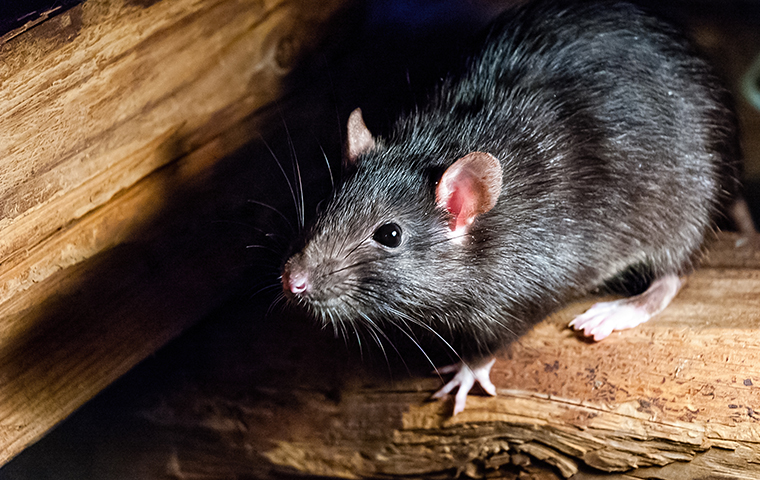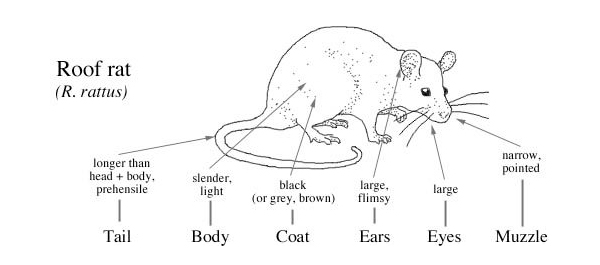RAT CONTROL AND PREVENTION
WHY THE CONCERN?
DISEASE
Rats are known to be able to transit a number of diseases directly (through bites) or indirectly through the bites of parasites found on the rat or by the contamination of food with urine or feces).
DAMAGE
Rats continually gnaw and dig as part of their nature. They damage wood, wiring, plasterboard and insulation. They undermine sheds and side-walks.

DO I HAVEARAT PROBLEM?
When determining whether rats have infested your property check for the following:
- Rat Droppings
1/2″ long; black with pointed ends; found scattered - Burrows
Rat burrows (holes) are 1-2″ in diameter (as compared to 6″ for muskrat burrows in ditchbanks); check near junk piles, sheds, foundations, composts, etc. Roof Rats prefer to nest in locations off the ground and rarely dig burrows for living quarters if off-the-ground sites exist. - Runways
Rats constantly explore and learn, memorizing the locations of pathways, obstacles, food and water, shelter, and features of their environment. They quickly detect and tend to avoid new objects and novel foods. Thus, they often avoid traps and baits for several days or more following their initial placement (neophobic). Roof rats have an excellent sense of balance and use their long tails to steady themselves along overhead utility lines or fence tops. - GnawMarks
Check around pipes, doorways, crawlspace vents, etc. - Listen to GNAWING SOUNDS or the sound of rats running in attics, crawlspace and walls.
RATS IN THIS AREA

The most common rat in this area is the ROOF RAT or sometimes called the Black Rat. If there is plenty of food and shelter, Roof Rats will gladly live in close proximity to humans, particularly in attics, ceilings, or wall areas. Rats are carnivorous; they will eat nearly all types of food including pet food, garbage, food scraps in composts, fallen fruit and nuts, and bird seed. Roof rats are agile climbers and usually live and nest above ground in shrubs, trees, and dense vegetation such as ivy. In buildings, they are most often found in enclosed or elevated spaces such as attics, walls, false ceilings, and cabinets.
Characteristics of a Roof Rat
- Sexual Maturity: 2-3 months
- Gestation Period: 2 days
- Litter Size: 6-8 per litter
- No. of Litters: 4-6 per year
- Feeding Habits: Steady eater but neophobic (wary of new objects)
- Diet: Fruits, vegetables, grains, nuts
- Length of Adult Life: 18 months
- Droppings: Approx. Avg. 1/2″ long; black with pointed ends; found scattered
- Nests: Trees, rooftops, attics; Up to 300ft. from food&water TIP: Extra pads and longer digits on their paws enable roof rats to be excellent climbers.
CONTROL OF RATS
Although an infestation of rats can be temporarily controlled with poisons or traps, permanent control can only be achieved if food and harbourage are removed.
RATS WILL NOT ESTABLISH THEMSELVES IN AN AREA WHERE THERE IS NO FOOD OR HARBOURAGE ELIMINATE HARBOURAGE
Remove unused piles of lumber and debris. Lumber and firewood should be stacked on stands so there is 6 -8″ clearance below the pile and between the pile and any wall. Cut weeds and ornamental shrubs so that they do not hang into ditches or provide hidden runways along fence lines.
ELIMINATE FOOD SOURCES
Ensure compost bins are secured. Avoid leaving pet food outside overnight. Garbage bags should not be used for waste food disposal; where their use is unavoidable, the bags should not be placed outside until garbage collection day; metal cans with tight fitting lids are the only truly rat-proof containers. Bird feeders should be equipped with trays to catch spillage; spilled feed should be cleaned up immediately. Remove fallen fruit and nuts. Clean out accumulated wastes and food from pet enclosures.
RAT-PROOF BUILDINGS
The most successful and long-lasting form of rat control in structures is exclusion, or “building them out”. Screen crawlspace and attic vents (metal screen only). Seal all gaps/holes larger than 1/4″ around all doorways and plumbing fixtures. Repair cracks in cement footings and foundations and any openings for water pipes, electric wires, sewer pipes, drain spouts, and vents. For roof rats in particular, thinning dense vegetation will make the habitat less desirable. Climbing hedges and honeysuckle on fences or buildings are conducive to roof rat infestations and should be thinned or removed if possible, as should overhanging tree limbs within 3 feet of the roof. Separate the canopy of densely growing plants from one another and from buildings by a distance of 2 feet or more to make it more difficult for rats to move between them.
POISON AND TRAPS
Read and follow label instructions on the poison package.
- Anti-coagulant type rat poisons are available from hardware stores. Extreme care must be taken when using poisons to prevent access by children and pets:
- Snap traps are recommended for control of rats where the use of poisons would be dangerous or where odours from dead rodents would be a problem. •
- For roof rats, place tamper resistant bait stations under decks, by compost bins, or along fence lines. If you place bait stations above ground level, take care that they are securely fastened where children or pets can’t find them. It may take several days for them to enter and feed in bait stations. Remember to remove and properly dispose of all uneaten bait at the end of a control program. Please note rat bait stations are NOT available in stores. To purchase a rat bait station, please contact a professional pest control company.
DISPOSAL
- Don’t touch rodents with your bare hands, and wash thoroughly after handling traps.
- Use disposable gloves to handle dead rodents.
- Dispose of dead rats by burying them or placing them in a sealed plastic bag and putting them in the trash.
NOTES
- A neighbourhood rat control program can ONLY be effective with the cooperation of ALL PROPERTY OWNERS.
- It is YOUR responsibility and in your best interest to keep rats from gaining a foothold in your neighbourhood.
- Keep all food and all garbage tightly covered.
- Rat-proof your property.
- Bird or pet food should be removed immediately a er feeding.
- Elevate stored materials.
- Get rid of trash.
- Organize a community meeting to collectively agree on measures to take as suggested in this pamphlet.


